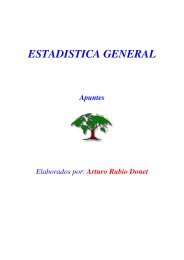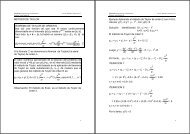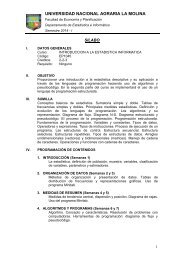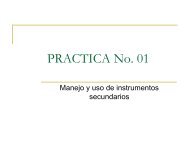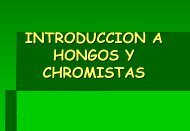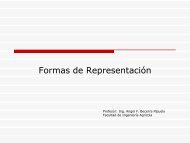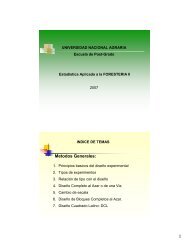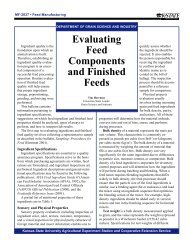You also want an ePaper? Increase the reach of your titles
YUMPU automatically turns print PDFs into web optimized ePapers that Google loves.
<strong>METODOS</strong> <strong>DE</strong> <strong>RUNGE</strong> <strong>KUTTA</strong>Los métodos de Runge-Kutta (RK) logran una exactitud del procedimiento de unaserie de Taylor, sin requerir el cálculo de derivadas superiores.Probablemente uno de los procedimientos más difundidos, y a la vez más exactos,para obtener la solución numérica del problema de valor inicial:y´ = f(t,y), con y(to) = yo, sea el método de Runge- Kutta de cuarto orden.Los métodos de Runge Kutta de cualquier orden se deducen mediante el desarrollode la serie de Taylor de la función f(t,y). Existen muchas variaciones, las cualestienen la forma:y i+1= y i+ h (a 1k 1+ a 2k 2+...+ a nk n) ,donde las a ison constantes y las k son:k 1= f(t i, y i)k 2= f(t i+ p 1h, y i+ q 11k 1h)k 3= f(t i+ p 2h, y i+ q 21k 1h + q 22k 2h)k n= f(t i+ p n-1h, y i+ q n-1,1k 1h + q n-1,2k 2h+…+ q n-1,n-1k n-1h)Notamos que los k son relaciones recursivas, es decir, para determinar k 2,necesitamos k 1; para determinar k 3se necesita k 2, etc1A continuación mencionaremos el teorema de taylor, el cual será usado para laobtención de los métodos de Runge Kutta.TEOREMA <strong>DE</strong> TAYLOR PARA FUNCION <strong>DE</strong> DOS VARIABLESSea f(t,y) una función de dos variables tal que todas las derivadas parciales deorden n+1 sean continuas en el rectángulo R ={(t,y)/ t-a h; y-b k},entonces existe un número tal que:21
<strong>METODOS</strong> <strong>DE</strong> <strong>RUNGE</strong> <strong>KUTTA</strong> <strong>DE</strong> SEGUNDO OR<strong>DE</strong>NDado el problema de v.i. : y´ = f(t,y), con y(t 0) = y 0(*)Aplicando la serie de Taylor para y(t + h):y(t + h) =y(t)+h y´(t) + h 2 y´´(t) /2 + h 3 y´´´(t)/6 + .... (1)De la ecuación(*), tenemos:y´(t) = fy´´(t) = f t+ f yy´ y´´(t) = f t+ f yfy´´´(t) = f tt+ f tyf + (f t+f yf) f y+f (f yt+ f yyf)Los tres primeros términos de la ecuación (1) se puede escribir como:y(t + h) = y(t)+h f + h 2 (f t+ f yf)/2 + O(h 3 )= y(t)+f + h(f + h f t+h f yf)/2 + O(h 3 ) (2)3Para eliminar las derivadas parciales, aplicaremos la serie de Taylor a la función f(t,y)de dos variables:f(t + h, y +h k 1) = f(t, y)+ h f t(t, y) + h f(t,y) f y(t, x) + O(h 2 ); donde k 1= f(t,y)De esto, la ecuación (2), se puede escribir:y(t + h) = y(t)+hf/2 + h(f(t + h, y +h)+O(h 2 ) )/2 + O(h 3 ), equivalentemente:y i+1= y i+ h (2´)donde: k 1= f(t i, y i)k k1 22k 2= f(t i+ h, y i+h k 1)Este método se conoce como el método de Runge-Kutta de segundo orden.También se conocen como el METODO <strong>DE</strong> HEUN.42
Generalmente las fórmulas de Runge-Kutta de segundo orden adoptan la forma:y(t+h) = y(t) +w 1h f(t,y) +w 2h f(t+h, y + h f(t, y)) +O(h 3 ) (3)donde w 1, w 2, , son parámetros a nuestra disposición.Aplicando la serie de Taylor de dos variables para la f(t+h, y+ h f(t, y)) en laecuación (3) se puede reescribir:y(t + h) = y(t) + w 1h f(t,y) + w 2h[f(t,y)+ h f t(t, y)+ h f(t, y) f y(t, y)] + O(h 3 ) (4)Al comparar (2) con (4), tenemos: w 1+w 2= 1 (5)w 2 = ½w 2 = ½Una solución es w 1= w 2= ½; = = 1, que corresponde al método de Heun de laecuación (2`) . El sistema de ecuaciones (5) poseen otras soluciones, como porejemplo: w1 =0, w 2= 1; = = ½ . La fórmula que se obtiene a partir de (3) seconoce como el método de euler modificado[1]:y(t + h) = y(t)+k 2, o equivalentemente:5[1] En alguno libros, este método, se conoce como el método del punto medio.y(t + h) = y(t)+k 2, o equivalentemente:y i+1= y i+ h k 2(4´)donde: k 1= f(t i, y i), k 2= f(t i+ h, y i+hk 1/2 )63
<strong>METODOS</strong> <strong>DE</strong> <strong>RUNGE</strong> <strong>KUTTA</strong> <strong>DE</strong> CUARTO OR<strong>DE</strong>NProbablemente uno de los procedimientos más difundidos, y a la vez, más exactopara obtener soluciones aproximadas del problema: y´ = f(t,y), con y(t 0) = y 0,sea el método de Runge Kutta de cuarto ordenAsí, como en el método de R.K. de segundo orden hay un número infinito deversiones, en el método de RK de cuarto orden existen infinitas versiones.Una de las versiones es:y i+ 1= y i+6h (k 1+ 2k 2+2k 3+ k 4)donde: k 1= f(t i, y i)k 2= f (t i+ h/2, y i+hk 1/2)k 3= f (t i+ h/2, y i+hk 2/2)k 4= f (t i+h , y i+ h k 3)7Ejemplo: Usando el método de RK4 clásico, con h=1, estimar y(2) en el P.V.I:y’ = 2 t y + t, con y(0) = 0.5, en el intervalo [0,2]Solución: Identificando: f(t,y)= 2 t y + t; t 0= 0; y 0= 0.5; h = 1Iteración1: y 1= y 0+h (k 1+ 2k 2+2k 3+ k 4)/6k 1= f(t 0;y 0)= f(0;0.5)= 2 0 0.5 + 0 = 0+ 1 -1 = 0k 2= f(t 0+h/2;y 0+h k 1/2) = f(0.5; 0.5) =2 0.5 0.5 + 0.5= 1k 3= f(t 0+h/2;y 0+h k 2/2) = f(0.5;1)= 2 0.5 1 + 0.5=1.5k 4= f(t 0+h,y 0+ h k 3) = f(1; 2)= 2 1 2 + 1= 5y 1= y 0+h (k 1+ 2k 2+2k 3+ k 4)/6 = 0.5+1(0 + 21 +2 1.5 + 5)/6= 2 .16667t 1= t 0+ h = 0 + 1 = 184
y 1= 2 .16667t 1= t 0+ h = 0 + 1 = 1Iteración2: y 2= y 1 +6h (k1 + 2k 2+2k 3+ k 4)k 1= f(t 1,y 1)= f(1; 2.16667 ) = 5.33333k 2= f(t 1+h/2,y 1+hk 1/2)= f(1.5; 4.83333)=16.k 3= f(t 1+h/2,y 1+h k 2/2)= f(1.5,10.1667)=32.k 4= f(t 1+h,y 1+ hk 3) =f (2; 34.1667) = 138.667y 2=2.16667+ (5.33333+ 216. + 2 32. + 138.667)= 42.1667t 2= t 1+ h = 1+ 1 = 2Por lo tanto, y(2) y(t 2)= 42.1667Finalmente, y(2) 42.16679Comparación las aproximaciones de y’ = 2 t y + t, con y( 0 )=0.5, en el intervalo[0,2], obtenidas con el método de Runge Kutta de orden 4 (clásico) paradiferentes tamaños de pasot yaprox yexacta0 0.5000 0.50001.0000 2.1667 2.21832.0000 42.1667 54.09820t yaprox yexacta0 0.5000 0.50000.2500 0.5645 0.56450.5000 0.7840 0.78400.7500 1.2550 1.25511.0000 2.2179 2.21831.2500 4.2685 4.27071.5000 8.9760 8.98771.7500 20.8212 20.88092.0000 53.7907 54.0982t yaprox yexacta0 0.5000 0.50000.5000 0.7839 0.78401.0000 2.2131 2.21831.5000 8.8724 8.98772.0000 51.5849 54.0982t yaprox yexacta0 0.5000 0.50000.1000 0.5101 0.51010.2000 0.5408 0.54080.3000 0.5942 0.59420.4000 0.6735 0.67350.5000 0.7840 0.78400.6000 0.9333 0.9333… ….. ….1.7000 17.4918 17.49331.8000 25.0307 25.03371.9000 36.4601 36.46612.0000 54.0863 54.0982105
Tabla Comparativa de los métodos de: Euler, Taylor de cuarto orden,Runge Kutta de orden 4 clásico, en la solución de la ecuación y’ = 2 t y + t,con y( 0 ) = 0.5, en el intervalo [0,2]t euler Taylor4 RK4 yHexactaL0 0.5 0.5 0.5 0.50.5 0.5 0.78125 0.783854 0.7840251. 1. 2.17261 2.21314 2.218281.5 2.5 8.49221 8.87236 8.987742. 7. 47.4819 51.5849 54.0982t euler Taylor4 RK4 yHexactaL0 0.5 0.5 0.5 0.50.2 0.5 0.5408 0.540811 0.5408110.4 0.58 0.673414 0.67351 0.6735110.6 0.7528 0.932998 0.933321 0.9333290.8 1.05347 1.39556 1.39644 1.396481. 1.55058 2.21586 2.21811 2.218281.2 2.37082 3.71429 3.71999 3.72071.4 3.74881 6.58191 6.5966 6.599331.6 6.12814 12.3865 12.4256 12.43581.8 10.3702 24.8874 24.9955 25.03372. 18.1967 53.6405 53.9539 54.098211Tabla Comparativa de los métodos de: Euler, Taylor de cuarto orden,Runge Kutta de orden 4 clásico, en la solución de la ecuación y’ = 2 t y + t,con y( 0 ) = 0.5, en el intervalo [0,2]t euler Taylor4 RK4 yHexactaL0 0.5 0.5 0.5 0.50.1 0.5 0.51005 0.51005 0.510050.2 0.52 0.540809 0.540811 0.5408110.3 0.5608 0.59417 0.594174 0.5941740.4 0.624448 0.673503 0.673511 0.6735110.5 0.714404 0.78401 0.784025 0.7840250.6 0.835844 0.933303 0.933329 0.9333290.7 0.996146 1.13227 1.13232 1.132320.8 1.20561 1.39641 1.39648 1.396480.9 1.4785 1.74779 1.7479 1.747911. 1.83463 2.21809 2.21827 2.218281.1 2.30156 2.85317 2.85346 2.853481.2 2.9179 3.72018 3.72065 3.72071.3 3.7382 4.91863 4.91938 4.919481.4 4.84013 6.59791 6.59912 6.599331.5 6.33537 8.98534 8.98734 8.987741.6 8.38598 12.4317 12.435 12.43581.7 11.2295 17.4862 17.4918 17.49331.8 15.2175 25.0213 25.0307 25.03371.9 20.8758 36.4439 36.4601 36.46612. 28.9986 54.0583 54.0863 54.0982126
RESUMENPara resolver la ecuación diferencial: y' = f(t,y); con y(t0)=y0,se tiene los siguientes métodos numéricos de un paso:13147



